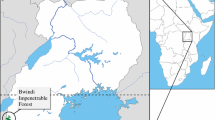Abstract
We compared the reproductive output, local recruitment rates and survival rates of 1 year old Coal Tit females breeding only once („group 1“) with the corresponding values of 1 year old females breeding twice („group 2“). One year old females which failed first or second broods were excluded. Survival was estimated by the local recovery rate of females during the next breeding season. Our data do not fit with the „cost of reproduction hypothesis“ as females with significantly higher reproductive output and recruitment („group 2“) did not show lower survival. We even found a significantly positive correlation between production of a second brood and recovery rate the next year.
Zusammenfassung
In einem Aufforstungsgebiet mit Japanlärche und Waldkiefer von 325 ha bei Lingen/Emsland mit 600 künstlichen Nisthöhlen konnten 1974–1993 jährlich 16–98 Brutpaare der Tannenmeise kontrolliert werden; rund zwei Drittel der Paare brüteten im Mittel aller Jahre zweimal pro Saison. Die Reproduktionsrate (Zahl flügger Nestlinge), die lokale Rekrutierungsrate (Zahl der sich fortpflanzenden geburtsortstreuen Jungvögel) und die Überlebensrate einjähriger Tannenmeisen-♀, die nur einmal brüteten (Gruppe 1), wird verglichen mit einjährigen ♀ mit zwei Bruten (Gruppe 2); einjährige ♀ mit mißglückter Erst- oder Zweitbrut blieben unberücksichtigt. Als Maß für die Überlebensrate gilt die lokale Wiederfangrate der ♀. Gruppe 2 hatte eine gesichert höhere Reproduktions- und Rekrutierungsrate als Gruppe 1, und zwar nicht nur im 1. Brutjahr, sondern auch über alle Lebenszeit-Brutjahre (lifetime reproduction). Zwischen Brutenzahl und Wiederfangrate der ♀ im jeweils nächsten Jahr besteht eine gesichert positive Beziehung. Dies dürfte auf im Duchschnitt bessere „Qualität“ der ♀ mit Zweitbruten zurückzuführen sein. Die Ergebnisse stimmen nicht mit der „cost of reproduction hypothesis“ überein.
Similar content being viewed by others
Literatur
Altenkirch, W., &W. Winkel (1991): Versuche zur Bekämpfung der Lärchenminiermotte (Coleophora laricella) mit Hilfe insektenfressender Singvögel. Waldhygiene 18: 233–255.
Askenmo, C. (1979): Reproductive effort and return rate of male Pied Flycatchers. Am. Nat. 114: 748–752.
Balen, J. H. van (1967): The significance of variations in body weight and wing length in the Great Tit,Parus major. Ardea 55: 1–59.
Boer-Hazewinkel, J. den (1987): On the cost of reproduction: Parental survival and production of second clutches in the Great Tit. Ardea 75: 99–110.
Bryant, D. M. (1979): Reproductive costs in the House Martin (Delichon urbica). J. Anim. Ecol. 48: 655–675.
Einloft-Achenbach, H., &K. H. Schmidt (1984): Die biologische Bedeutung von Ersatzbruten bei Kohlmeisen (Parus major). Vogelwarte 32: 161–182.
Ekman, J., &C. Askenmo (1986): Reproductive cost, age-specific survival and a comparison of the reproductive strategy in two european tits (genusParus). Evol. 40: 159–169.
Högstedt, G. (1981): Should there be a positive or negative correlation between survival of adults in a bird population and their clutch size? Am. Nat. 118: 568–571.
Horn, H. S. (1978): Optimal Tactics of Reproduction and Life—History. In:Krebs, J. R., &N. B. Davies, Behavioural ecology — an evolutionary approach: 411–429. Oxford.
Korpimaki, E. (1991): Lifetime reproductive success of male Tengmalm's Owls. Acta XX Congr. Int. Orn.: 1528–1541.
Lemon, W. C. (1993): The energetics of lifetime reproductive success in the Zebra FinchTaeniopygia guttata. Physiol. Zool. 66: 946–963.
Lindén, M., &A. P. Møller (1986): Cost of reproduction and covariation of life history traits in birds. Trends in Ecol. and Evol. 4: 367–371.
Noordwijk, A. J. van, &G. de Jong (1986): Acquisition and allocation of resources: their influence on variation in life history tactics. Am. Nat. 128: 137–142.
Nur, N. (1988a): The cost of reproduction in birds: an examination of the evidence. Ardea 76: 155–168.
Ders. (1986b): The consequences of brood size for breeding blue titis III. Measuring the cost of reproduction: Survival, future fecundity, and differential dispersal. Evol. 42: 351–362.
Perrins, C. (1979): British Tits. London.
Røskaft, E. (1985): The effect of enlarged brood size on the future reproductive potential of the Rook. J. Anim. Ecol. 54: 255–260.
Smith, J. N. M. (1981): Does high fecundity reduce survival in Song Sparrows? Evol. 35: 1142–1148.
Stearns, S. (1989): Trade-offs in life history evolution. Funct. Ecol. 3: 259–268.
Steven, D. de (1980): Clutch size, breeding success, and parental survival in the Tree Swallow (Iridoprogne bicolor). Evol. 34: 278–291.
Tinbergen, J. M., J. H. van Balen &H. M. van Eck (1985): Density dependent survival in an isolated Great Tit population: Kluyver's data reanalysed. Ardea 73: 38–48.
Winkel, W. (1975): Vergleichend—brutbiologische Untersuchungen an fünf Meisen-Arten (Parus spp.) in einem niedersächsischen Aufforstungsgebiet mit Japanischer LärcheLarix leptolepis. Vogelwelt 96: 41–63; 104–114.
Ders. (1981): Zum Ortstreue-Verhalten von Kohl-, Blau — und Tannenmeise (Parus major, P. caeruleus, P. ater) in einem 325 ha großen Untersuchungsgebiet. Vogelwelt 102: 81–106.
Ders. (1984): Altersklassen und Überlebensrate weiblicher Tannenmeisen (Parus ater). Vogelwarte 32: 298–302.
Ders. &D. Winkel (1987): Gelegestärke und Ausfliege-Erfolg bei Erst- und Zweitbruten von Kohl- und Tannenmeisen (Parus major, P. ater). Befunde aus einem Lärchenforst. Vogelwelt 108: 209–220.
Dies. (1988): Zur Abwanderung von Kohl- und Tannenmeisen (Parus major, P. ater) eines Lärchen-Versuchsgebietes. Vogelwarte 34: 225–232.
Author information
Authors and Affiliations
Rights and permissions
About this article
Cite this article
Winkel, W., Winkel, D. Kosten und Nutzen von Zweitbruten bei der Tannenmeise (Parus ater). J Ornithol 136, 29–36 (1995). https://doi.org/10.1007/BF01647205
Published:
Issue Date:
DOI: https://doi.org/10.1007/BF01647205




